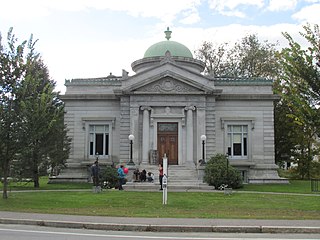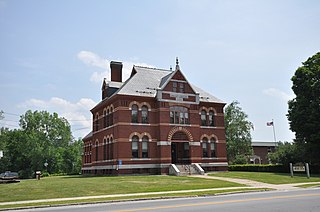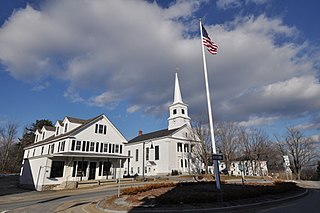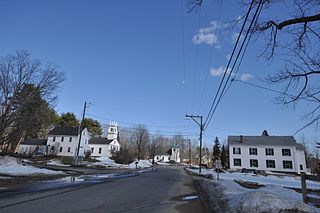
Frederick Smyth was an American banker, railroad executive, and politician from Manchester, New Hampshire. Born in 1819 in Candia, New Hampshire, he became City Clerk of Manchester at the age of 30. A Republican, he served four terms as mayor of Manchester from 1852 to 1854 and again in 1864, and was the 30th governor of New Hampshire.

The Valley Cemetery is a public cemetery located in Manchester, New Hampshire, United States. It is bounded on the east by Pine Street, on the north by Auburn Street, on the west by Willow Street, and on the south by Valley Street, from which it derives its name. It was listed on the U.S. National Register of Historic Places in 2004, and the New Hampshire State Register of Historic Places in 2003.

The Candia Four Corners is an unincorporated community located near the center of the town of Candia, New Hampshire, in the United States.

Sanborn Seminary is a historic educational facility in Kingston, New Hampshire. Its main building was built in 1883 by Major Edward S. Sanborn to serve as a secular secondary boarding school. The school ran continuously until 1966 when it was sold to the Town of Kingston. The campus became known as Sanborn Regional High School and served students from the towns of Kingston, Newton, and Fremont. The last class at this campus graduated in June 2006.

The Portsmouth Athenæum is an independent membership library, gallery, and museum in Portsmouth, New Hampshire, United States. It preserves and provides access to an extensive collection of manuscripts, rare books, photographs, artworks and artifacts, and digital collections related to local history and genealogy, in addition to a circulating library for its membership. As an intellectual center of the community, it sponsors exhibitions, concerts, lectures, and other educational and cultural programs. The building, dating to 1805, has been listed on the National Register of Historic Places since 1973.

The Goffstown Public Library is located at 2 High Street in Goffstown, New Hampshire. The building it occupies was designed by architects Henry M. Francis & Sons and was built in 1909. It is small Classical Revival building built of brick with stone trim, and was added to the National Register of Historic Places in 1995. It is one of the finest examples of Classical Revival architecture in the town, with a three-bay main facade whose central entrance projects slightly, and is topped by a pediment supported by Ionic columns.

The Gordon-Nash Library is a private non-profit library at 69 Main Street in New Hampton, New Hampshire. Founded in 1887, the library is "the only private non-profit library in New Hampshire that is open to all residents, students and sojourners," and effectively functions as New Hampton's public library. It is housed in an 1895 Renaissance Revival building that was listed on the National Register of Historic Places in 1988.
Maurice B. Biscoe was an American architect. He worked in New York and then moved to Denver, Colorado. He returned to the east to work in Boston. A number of his works are listed on the U.S. National Register of Historic Places. His work was also part of the architecture event in the art competition at the 1932 Summer Olympics.

The Shedd-Porter Memorial Library, located at 3 Main Street, is the public library of Alstead, New Hampshire. The library building was a gift to the town from John Graves Shedd and Mary Roenna (Porter) Shedd, and is a Beaux Arts building built in 1910 to a design by William H. McLean and Albert H. Wright. Shedd also donated 2,000 books to the library, whose collection now exceeds 10,000 volumes. The library building, one of the finest of the period in the state, was listed on the National Register of Historic Places in 2010, and the New Hampshire State Register of Historic Places in 2011.

The Conant Public Library is the public library of Winchester, New Hampshire. It is located at 111 Main Street, in a fine Victorian Romanesque Revival building erected in 1891, funded by a bequest from Winchester resident Ezra Conant. The building's design, by Springfield, Massachusetts architect, J. M. Currier, is based on his design of the 1886 library building in Brattleboro, Vermont, and is one of the most architecturally distinguished buildings in Cheshire County. It was listed on the National Register of Historic Places in 1987.

The Haverhill Corner Historic District encompasses the early civic center of Haverhill, New Hampshire, United States. The district is focused on the junction of New Hampshire Route 10 and Court Street, which was historically a major through route. Court Street is flanked at the junction by a pair of large grassy common areas which are bounded by School Street and Route 10. Buildings, predominantly Federal in character and built in the late 18th and early 19th centuries, are arrayed around these commons, and historic buildings line Route 10 and Court Street for a short distance away from the commons. Prominent buildings in the district include the 1827 Federal-style First Congregational Church, the 1840 former courthouse that now houses the public library and local historical society, and the Romanesque Revival 1897 Haverhill Academy Junior High School building. The area declined in importance after the railroad bypassed it, resulting in the gradual relocation of civic functions to the Woodsville area. The district was listed on the National Register of Historic Places in 1987.

The Dublin Village Historic District encompasses the historic village center of Dublin, New Hampshire. Dublin's center developed in the 19th century after its original village center was abandoned due to harsher winter conditions nearer Dublin Pond. The district extends along Main Street from its junction with Lake Street in the west to the junction with Old County Road in the east, and includes sections of Old Common Road, Harrisville Road, and Church Street. The district was listed on the National Register of Historic Places in 1983.

The Cook Memorial Library is the public library of Tamworth, New Hampshire. It is located at 93 Main Street in the center of the town, in an 1895 Queen Anne Victorian building which is listed on the National Register of Historic Places. The library's origins are in a private "social library" established in 1796 by Parson Samuel Hidden; the building was given in memory of Charles Cook, a prominent local businessman and politician.

The Smyth Tower is a folly located on the grounds of the Manchester VA Medical Center at 718 Smyth Road in Manchester, New Hampshire. The fieldstone tower was built in 1888 by Frederick Smyth, and is the only surviving architectural structure related to his life. Smyth served as Governor of New Hampshire in 1865-67, and was an active promoter of veterans' issues in the post-Civil War period. The tower was listed on the National Register of Historic Places in 1978.

The Acworth Silsby Library is the public library of Acworth, New Hampshire, located in the town center at 5 Lynn Hill Road. Built in 1891 and funded by Acworth native Ithiel Homer Silsby, the building is a distinctive local example of Romanesque architecture. The building was listed on the National Register of Historic Places in 1983.

The Deerfield Center Historic District encompasses the heart of the rural New Hampshire town of Deerfield. It extends northwest along Church Street from its junction with North Road, Candia Road, and Raymond Road. It includes many of the town's municipal buildings, as well as a church and private residences, most of which were built before about 1920. The district was listed on the National Register of Historic Places in 2002.

The Seth Mason Richards House, housing the Richards Free Library and the Library Arts Center, is a historic house, public library, and art gallery at 58 North Main Street in Newport, New Hampshire. This three-story Colonial Revival house was designed by Boston, Massachusetts architect James T. Kelley and built in 1898-99 for Captain Seth Mason Richards, a scion of one of Newport's wealthiest families. The property, including the house and carriage house, were donated by his heirs for use as the town's public library in 1962. The library is housed in the main building, while the carriage house has been converted for use as a gallery space. The property was listed on the National Register of Historic Places in 1984.

The Belmont Library is the public library of Belmont, New Hampshire. It is located at 146 Main Street, in an architecturally distinguished single-story brick Colonial Revival structure designed by Wells & Hudson and built in 1927-28.

The Gilmanton Ironworks Library is a historic library building at 10 Elm Street in the Iron Works village of Gilmanton, New Hampshire. Built in 1916-17, it was the first Colonial Revival library building in Belknap County. The building, still serving as a branch of the Gilmanton public library system, was listed on the National Register of Historic Places in 1989.

The Ossian Wilbur Goss Reading Room is a historic library building at 188 Elm Street in the Lakeport section of Laconia, New Hampshire. The architecturally eclectic single-story brick building was designed by Boston architect Willard P. Adden and built in 1905-06 after the collection of the former Lakeport library was moved to the recently built Gale Memorial Library in the center of Laconia. Its construction was funded by a bequest from Ossian Wilbur Goss, a local doctor who had died without natural heirs. The building officially became a branch of the Laconia library system in 1909, and continues to be administered in part by trustees of Goss's legacy. The building was listed on the National Register of Historic Places in 1986.






















